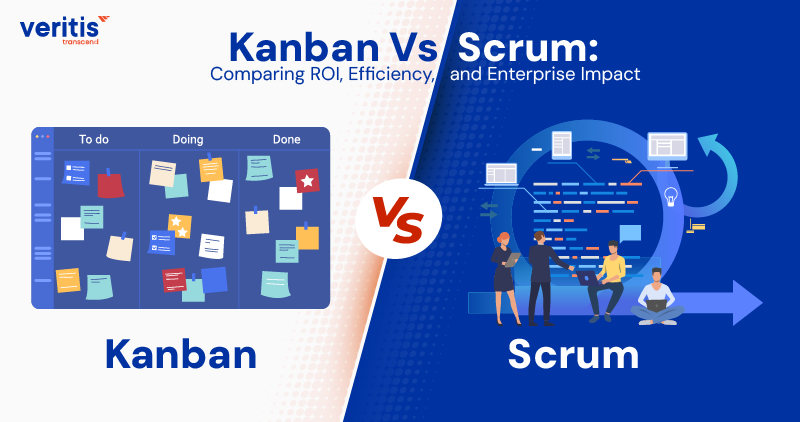
Every digital initiative today runs on agility. Yet one strategic question divides even the most experienced leaders: Kanban vs Scrum. Both are proven Agile project management frameworks, but their philosophies differ in how they deliver value, adapt to change, and scale across the enterprise.
For executives leading modernization programs, this is not a tool debate. It’s a decision about speed, control, and business agility. Kanban for software development offers fluidity and real time adaptability. Scrum enforces structure and sprint based accountability. The balance between these models defines how effectively teams convert effort into enterprise outcomes.
At Veritis, we view the Agile Scrum vs Kanban discussion as a leadership decision, not a development preference. Our experience across 600+ enterprise projects shows that the right framework can accelerate delivery speed by up to 40% while strengthening collaboration and governance. The Kanban development methodology supports continuous flow and operational efficiency, while Scrum drives focus, structure, and measurable output.
As organizations adopt Agile software development practices to improve responsiveness, predictability, and ROI, understanding when to deploy each approach becomes critical. Whether your enterprise values flexibility or cadence, flow or focus, Veritis helps align these models to your strategic goals, ensuring agility translates directly into business value.
Talk to an Agile Transformation Expert
What is Kanban?
Kanban is one of the most adaptive Agile project management frameworks, designed to bring transparency, flexibility, and efficiency to complex delivery environments. Originating from Lean principles, the Kanban development methodology focuses on optimizing workflow by visualizing tasks, limiting work in progress, and fostering continuous improvement.
Kanban is Best For
Kanban for software development is ideal for teams managing dynamic workloads, such as application support, maintenance, or operational enhancement projects. Enterprises that experience frequent priority changes or need continuous delivery cycles benefit from this model.
At Veritis, we’ve seen organizations using Kanban for software development improve cycle time by up to 35% and cut work bottlenecks by nearly half through real time visualization and flow optimization.
Kanban is best suited when:
- Tasks arrive unpredictably and must be handled continuously.
- Work requires high flexibility without strict sprint boundaries.
- Teams support ongoing releases rather than time boxed iterations.
- There is a focus on throughput, quality, and incremental delivery.
Kanban Software
Modern Kanban software tools like Jira, Trello, ServiceNow, and Azure Boards enable teams to visualize their entire process on a Kanban vs Scrum board, tracking every task from “To Do” to “Done.” These tools integrate seamlessly with agile IT service management and DevOps consulting services, giving leaders real time insight into performance metrics such as lead time, throughput, and efficiency.
Through enterprise DevOps consulting services, Veritis helps clients implement these digital boards at scale, aligning operations, development, and governance through data driven agility.
Core Principles of Kanban
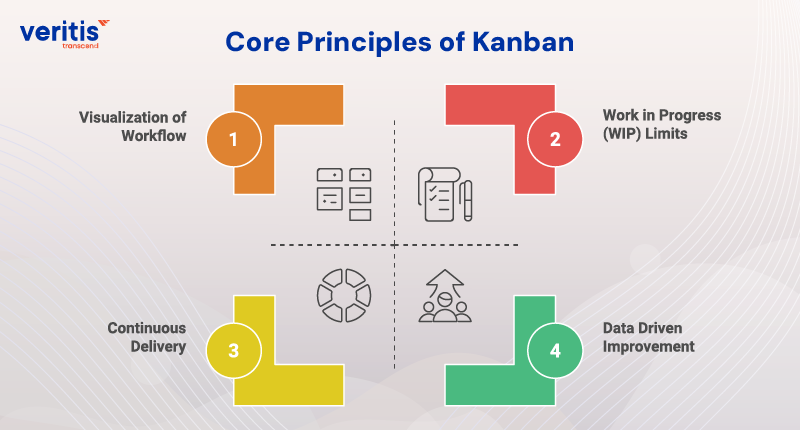
The Kanban development methodology is built on four core principles that make it distinct in the Agile software development practices landscape:
1) Visualization of Workflow: Every work item is represented on a Kanban board, providing immediate visibility into progress, bottlenecks, and ownership.
2) Work in Progress (WIP) Limits: By restricting simultaneous tasks, Kanban enhances focus and reduces context switching, improving throughput by up to 25%.
3) Continuous Delivery: Unlike Scrum, Kanban operates in a flow based system, where work is pulled as capacity becomes available, ensuring seamless delivery.
4) Data Driven Improvement: Teams monitor cycle time, lead time, and service levels to drive continuous optimization.
These characteristics make Kanban a powerful element in Agile methodologies comparison, particularly for enterprises prioritizing adaptability, customer responsiveness, and resource efficiency.
Roles in Kanban
Unlike Scrum, Kanban does not prescribe fixed roles such as Product Owner or Scrum Master. Teams can retain their existing structure and evolve organically. However, successful Kanban implementations often define implicit leadership roles:
- Service Delivery Manager: Oversees the flow, ensures work items move smoothly, and monitors WIP.
- Service Request Manager: Prioritizes incoming work and aligns it to business goals.
- Team Members: Collaboratively pull and deliver tasks as capacity allows.
Veritis integrates these roles within its enterprise DevOps consulting services, ensuring each responsibility ties directly to measurable outcomes. This clarity allows executives to scale agility without reorganizing existing hierarchies, maintaining business continuity while driving transformation.
Useful Link: Agile Transformation: Empowering Businesses to Adapt and Thrive
What is Scrum?
Scrum is among the most commonly implemented Agile project management frameworks, enabling teams to deliver complex products in short, time boxed iterations called sprints. It brings structure, discipline, and measurable progress to Agile software development practices, making it a cornerstone for organizations pursuing predictable and scalable delivery models.
Scrum is Best For
Scrum works best for enterprises that need iterative development, clearly defined goals, and predictable release cycles. Unlike Kanban’s continuous flow, Scrum focuses on structured planning and commitment. It is ideal for:
- Teams developing new software products or large scale system upgrades.
- Projects that benefit from fixed sprint timelines and measurable goals.
- Organizations adopting structured types of agile methodologies like SAFe or LeSS.
- Environments where accountability, cadence, and defined deliverables matter.
At Veritis, we’ve seen that enterprises using Scrum as part of their Agile software development practices experience up to 40% faster feature delivery and 30% improved sprint predictability, especially when paired with enterprise DevOps consulting services that automate build, test, and release cycles.
Scrum Software
Modern enterprises rely on Scrum software to digitize, automate, and scale agile delivery processes. These tools bring the principles of Scrum, such as transparency, collaboration, and continuous improvement, into real time execution environments. In the landscape of distributed teams and hybrid work, Scrum software has become an essential part of Agile software development practices and Agile project management frameworks.
Popular platforms, including Jira Software, Azure DevOps, ServiceNow Agile, and ClickUp, enable teams to manage sprint planning, backlog prioritization, and progress tracking within a single platform. Each system provides a Scrum board that visualizes sprint progress, making it easy to compare work efficiency across Kanban vs Scrum board models.
In Veritis transformation projects, these digital tools connect directly with CI/CD pipelines, testing frameworks, and DevOps consulting services. This integration enables leaders to monitor sprint outcomes, quality trends, and release readiness in real time. It also helps organizations understand the difference between Scrum and Kanban through data driven insights.
When implemented with the right strategy, Scrum software converts agile principles into measurable business performance and stronger delivery predictability, ensuring faster time to market and improved ROI.
The kanban vs scrum board comparison often begins here, in how work is visualized and executed. A Scrum board represents tasks within a specific sprint, typically divided into columns such as “To Do,” “In Progress,” and “Done.” Once a sprint ends, the board resets, creating a clear cycle of delivery and reflection.
In contrast to a persistent Kanban board, the Scrum board reinforces focus, time management, and accountability, every sprint becomes a commitment to business value.
When integrated with DevOps consulting services, the Scrum board connects with automation pipelines, enabling continuous testing, sprint monitoring, and post sprint reporting, giving executives full visibility into progress, risks, and ROI.
Core Principles of Scrum
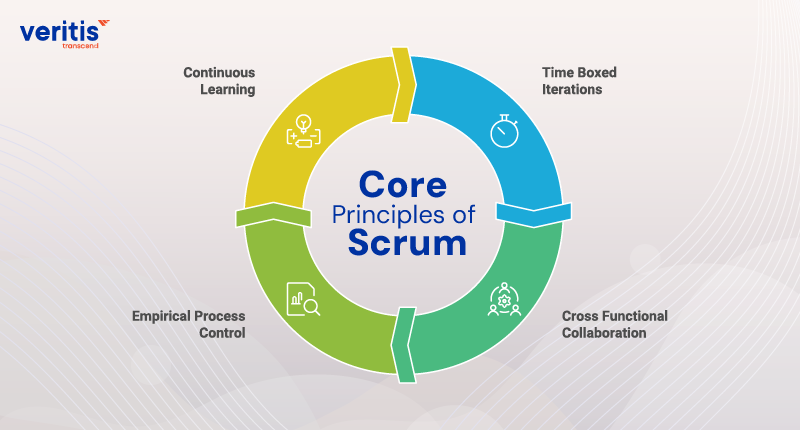
Scrum thrives on a combination of discipline and adaptability. Key principles include:
1) Time Boxed Iterations: Each sprint (usually 1–4 weeks) delivers a potentially shippable increment, ensuring consistent value delivery.
2) Cross Functional Collaboration: Developers, testers, and business stakeholders work as one unit with shared accountability.
3) Empirical Process Control: Transparency, inspection, and adaptation form the feedback loop that drives performance.
4) Continuous Learning: Regular retrospectives help teams identify bottlenecks and improve continuously, a core difference between Scrum and Kanban.
These principles make Scrum particularly effective in industries with high regulatory or customer demands, where consistent cadence, progress tracking, and quality assurance are non negotiable.
Roles in Scrum
Scrum defines three primary roles that shape collaboration and accountability within Agile software development practices:
- Product Owner: Represents customer interests, manages backlog prioritization, and ensures business goals align with sprint deliverables.
- Scrum Master: Acts as a mentor and guide, ensuring adherence to Scrum values and removing delivery obstacles.
- Development Team: Cross functional members who design, build, and test deliverables within each sprint.
This clear role definition helps reduce ambiguity, one of the main Kanban vs Scrum differences, and ensures business alignment from planning to delivery.
Veritis integrates these roles into its enterprise delivery model through enterprise DevOps consulting services, ensuring every sprint connects to measurable performance, governance, and automation outcomes. Our clients leverage this structured agility to achieve faster time to market and sustained ROI, proving that the real strength of Scrum lies in its ability to deliver value with predictability and transparency.
Useful Link: Waterfall Vs Agile Vs DevOps: Which Production Method Should You Take?
When to Use Kanban?
The Kanban development methodology fits environments that demand adaptability, real time visibility, and continuous delivery. Executives often prefer Kanban for software development when work is ongoing rather than project bounded.
Kanban is most effective when:
- Work arrives unpredictably. Teams handle a steady inflow of tickets, tasks, or support requests that must be prioritized continuously.
- Priorities shift frequently. Kanban enables flexible reordering without disrupting flow, a key advantage in Agile software development practices.
- Delivery is continuous. Ideal for maintenance, operations, and product support where outcomes evolve incrementally.
- You need visualization and control. The Kanban board vs Scrum board comparison shows how Kanban provides a live picture of WIP, cycle time, and bottlenecks.
- Integration with DevOps is essential. Kanban aligns naturally with CI/CD and agile IT service management, promoting faster feedback and stability.
At Veritis, enterprises adopting Kanban for software development often reduce average lead time by 25 to 40 percent and achieve measurable gains in delivery consistency through our enterprise DevOps consulting services.
When to Use Scrum?
Scrum is best for organizations that thrive on structure, iteration, and measurable progress. It provides the discipline needed for projects with clear goals and defined timeframes, making it one of the most reliable Agile project management frameworks.
Scrum is most effective when:
- You need predictability. Each sprint defines a short cycle of planning, execution, and review, giving executives visibility into results.
- Requirements can be planned in increments. Perfect for product development or feature releases where the scope evolves through iteration.
- Teams are cross functional. Collaboration among developers, testers, and business analysts is central to Scrum success.
- You value structured accountability. Scrum ceremonies and roles create ownership and rhythm that drive delivery confidence.
- Measurement matters. Metrics such as speed, sprint success rate, and burndown charts align performance with ROI goals.
Veritis clients who adopt Scrum within Agile software development practices report up to 40 percent faster release cycles and stronger governance when integrated with DevOps consulting services. The clear cadence and metrics make it easier for leadership to align delivery with business priorities.
Useful Link: Explained: Pros and Cons of DevOps Methodology and its Principles
Implementation Considerations: What to Watch For
Adopting Kanban or Scrum successfully requires more than following rituals or using visual boards. It demands disciplined execution, continuous monitoring, and alignment with business outcomes. The distinction between a mature agile team and a struggling one often lies in how effectively these principles are implemented within Agile software development practices.
How Can You Implement Scrum Effectively for Consistent Value Delivery?
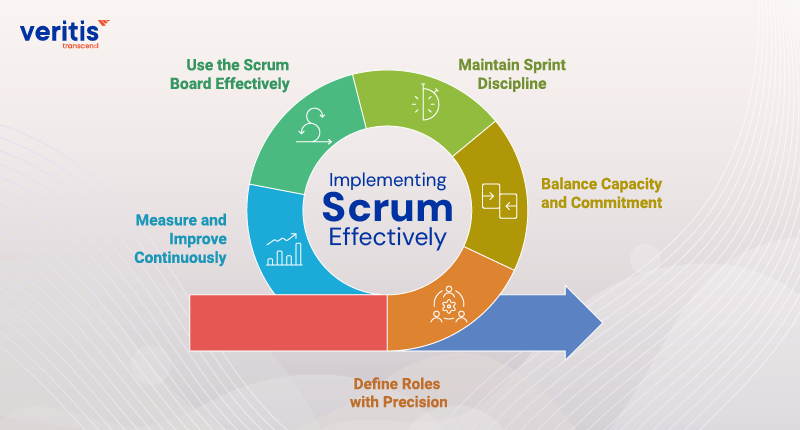
Scrum offers a powerful rhythm for iterative delivery, but it succeeds only when structure and clarity are maintained. To achieve consistent value, executives should focus on five core areas:
1) Define Roles with Precision
Clear distinctions between the roles of Product Owner, Scrum Master, and Development Team are essential. When responsibilities overlap, it leads to confusion and weakens accountability.
2) Balance Capacity and Commitment
Overloading the sprint backlog reduces quality and predictability. Set realistic goals based on historical speed and the team’s actual capacity to maintain delivery credibility.
3) Maintain Sprint Discipline
Avoid frequent mid sprint changes. Once the sprint begins, scope stability enables teams to focus and deliver consistent results.
4) Use the Scrum Board Effectively
A properly managed Scrum board reflects progress from backlog to completion. Each sprint cycle should reset cleanly to maintain transparency and rhythm. Comparing your kanban vs scrum board performance provides valuable insights into throughput and bottlenecks.
5) Measure and Improve Continuously
Track speed, sprint burndown, and retrospective action items. These metrics reveal performance trends and enable continuous improvement, a hallmark of strong Agile project management frameworks.
Veritis helps enterprises embed these practices through enterprise DevOps consulting services, integrating sprint analytics with automated dashboards that link performance data to ROI and executive reporting.
How Can You Implement Kanban Effectively for Consistent Value Delivery?
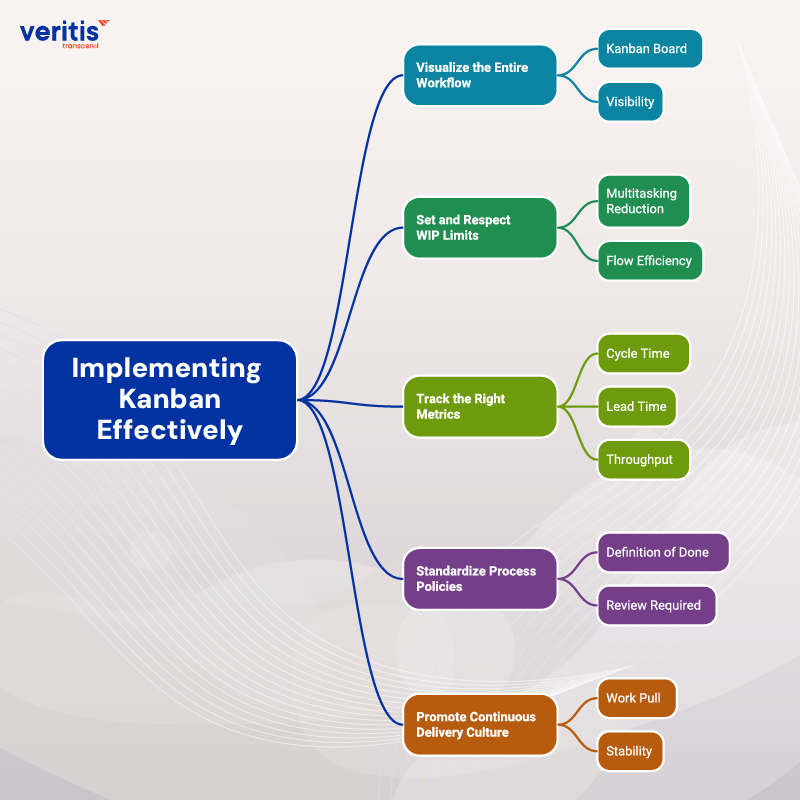
The Kanban development methodology relies on visual flow and adaptive work management. Its success depends on how well the process is designed, visualized, and improved over time.
1) Visualize the Entire Workflow
Use a Kanban board with clearly defined columns that represent each stage of work. Visibility builds accountability, helping leaders identify bottlenecks early and redistribute capacity.
2) Set and Respect WIP Limits
Limiting work in progress reduces multitasking and drives flow efficiency. Teams adopting Kanban for software development often achieve up to 30 percent faster delivery once WIP is optimized.
3) Track the Right Metrics
Monitor cycle time, lead time, and throughput. Use cumulative flow diagrams to assess balance and identify constraints. These insights feed directly into data driven improvement cycles.
4) Standardize Process Policies
Make criteria for moving work items clear. Explicit rules such as “definition of done” or “review required” reduce rework and support consistent delivery quality.
5) Promote Continuous Delivery Culture
Encourage teams to pull work when ready, not push it prematurely. This mindset ensures stability and reduces burnout, key advantages in the Kanban vs Scrum comparison.
Through DevOps consulting services, Veritis integrates Kanban workflows with automation and performance monitoring, enabling real time visibility and continuous optimization across large enterprise ecosystems.
Useful Link: AWS DevOps Services – Drive your DevOps Journey with AWS Seamless Flow
Aligning with Agile IT Service Management
Within agile IT service management environments, where tasks are reactive and flow based, Kanban typically provides better operational control. Its flexibility matches the unpredictable nature of support, maintenance, and infrastructure operations.
Scrum, however, remains valuable for structured modernization programs or IT initiatives that demand iteration and stakeholder visibility. Many Veritis clients adopt a hybrid approach that blends both frameworks, leveraging Kanban for stability and Scrum for transformation.
When reinforced with enterprise DevOps consulting services, this alignment creates a unified delivery model that connects development, operations, and governance. The result is an agile ecosystem where responsiveness meets reliability and every cycle delivers measurable business value.
ROI and Metrics for Building a Strong Business Case
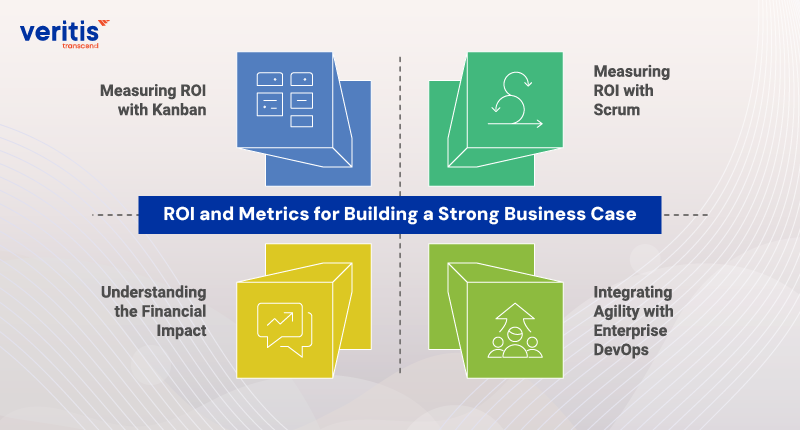
Delivering enterprise agility is not about adopting a framework. It is about proving measurable impact.
When organizations evaluate Kanban vs Scrum, the discussion must shift from tools to outcomes. Leaders invest in speed, predictability, and financial return, not in rituals. The success of any framework within Agile software development practices and Agile project management frameworks lies in how clearly it links performance to ROI.
1) Measuring ROI with Scrum
Scrum delivers results through structure, cadence, and transparency. Enterprises moving from waterfall delivery to Scrum often experience a visible performance transformation within the first year.
Observed Gains
- Productivity improves between 20 and 40 percent due to focused sprint cycles and cross functional collaboration.
- Forecast accuracy rises as sprint goals and retrospectives sharpen team discipline.
- Faster feedback loops and defect reduction lower total delivery cost and rework.
A well governed Scrum model, implemented with enterprise DevOps consulting services, aligns every sprint with measurable business outcomes. It connects speed, value, and visibility, three levers that every executive tracks.
2) Measuring ROI with Kanban
The Kanban development methodology emphasizes continuous flow, visual management, and waste reduction. Organizations using Kanban for software development achieve higher delivery speed and operational stability.
Measured Impact
- Average lead time drops by 30 percent, improving customer response and release readiness.
- Controlled work in progress eliminates multitasking inefficiency, raising throughput by 15 percent.
- Visual transparency through the Kanban board vs Scrum board view enables early detection of bottlenecks, cutting cycle time by as much as 40 percent.
With the support of DevOps consulting services, Kanban moves from an operational tool to a predictive performance system that ensures consistency and agility across enterprise functions.
3) Understanding the Financial Impact
Speed and flow are not abstract metrics; they represent direct financial advantage. Reducing feature delivery time from four months to three through Scrum accelerates revenue realization by nearly 25 percent. Implementing Kanban may shorten that cycle further to two and a half months, unlocking even greater value and customer satisfaction.
These measurable outcomes make every Agile methodologies comparison a strategic decision. For executive leaders, agility becomes an investment in faster capital recovery, higher innovation capacity, and improved market responsiveness.
4) Integrating Agility with Enterprise DevOps
When enterprises partner with Veritis through DevOps consulting services or enterprise DevOps consulting services, Scrum and Kanban are embedded within automation pipelines, test frameworks, and release workflows.
Scrum Integration
- Sprint increments synchronize with automated deployment schedules.
- Performance dashboards track speed, burn rates, and sprint ROI.
Kanban Integration
- Continuous flow connects directly to CI/CD pipelines.
- Metrics like WIP, deployment frequency, and defect rates unify across teams.
This integration delivers enterprise wide visibility, reduced friction, and continuous optimization. It transforms Kanban vs Scrum from a methodological choice into a business performance strategy, one that drives speed, quality, and scale in every delivery cycle.
Scrum Implementation Risks and Mitigations
1) Unrealistic Sprint Commitments
Teams often overestimate their sprint capacity, leading to burnout and missed goals.
Mitigation: Use historical speed data for planning and involve the team in commitment decisions to ensure balanced workloads.
2) Mid Sprint Scope Changes
Scope creep during a sprint disrupts focus and reduces delivery predictability.
Mitigation: Reinforce sprint discipline and move new requests to future backlog cycles where possible.
3) Undefined Roles and Responsibilities
When the roles of Product Owner, Scrum Master, or Development Team overlap, accountability weakens.
Mitigation: Define responsibilities clearly and invest in training to strengthen role ownership.
4) Inconsistent Sprint Reviews and Retrospectives
Skipping reviews limits feedback loops and reduces improvement opportunities.
Mitigation: Conduct every sprint review and retrospective as non negotiable practices within Agile project management frameworks.
5) Lack of Performance Transparency
Without clear reporting, executives lose sight of progress and ROI.
Mitigation: Integrate sprint metrics into enterprise dashboards through DevOps consulting services, enabling visibility across speed, quality, and outcomes.
Kanban Implementation Risks and Mitigations
1) Uncontrolled Work in Progress
Without defined WIP limits, teams face overload and delivery stalls.
Mitigation: Set explicit WIP thresholds and review them regularly to maintain flow efficiency in Kanban for software development.
2) Weak Process Visualization
A poorly designed Kanban board vs Scrum board comparison often reveals hidden work that hinders transparency.
Mitigation: Keep workflow columns clear, update tasks daily, and make policies visible to all stakeholders.
3) Absence of Regular Reviews
Kanban’s continuous flow can drift without structured reflection.
Mitigation: Schedule periodic service reviews or retrospectives to evaluate performance trends and improvement areas.
4) Incomplete Metrics and Monitoring
Failure to track cycle time, lead time, or throughput leads to missed optimization opportunities.
Mitigation: Use analytics tools and integrate data into centralized dashboards supported by enterprise DevOps consulting services.
5) Cultural Resistance to Continuous Flow
Teams accustomed to rigid planning may struggle with Kanban’s adaptive nature.
Mitigation: Provide change management coaching and emphasize the business impact of flow based agility within Agile software development practices.
Useful Link: DevOps Configuration Management: A Guide to the Top Tools in the Field
What is the Difference Between Scrum and Kanban?
Understanding the difference between Scrum and Kanban helps leaders choose the right model for delivery excellence. Both play vital roles in Agile software development practices, but their approach to planning, flexibility, and measurement differs significantly.
| Dimension | Scrum | Kanban |
| Cadence | Operates in fixed sprints of one to four weeks with defined goals and reviews. | Works in continuous flow without timeboxes; tasks move as capacity becomes available. |
| Roles | Structured roles include Product Owner, Scrum Master, and Development Team. | No required roles; teams retain existing structure and accountability. |
| Planning | Scope defined at the start of each sprint; changes limited mid cycle. | Uses in time planning; new work can enter as space opens. |
| Workflow | Focused on sprint backlog; each cycle ends with a review and reset. | Continuous workflow visualized through a Kanban board that never resets. |
| Metrics | Tracks speed, burndown rate, and sprint success percentage. | Tracks lead time, cycle time, throughput, and WIP levels. |
| Adaptability | Best for structured teams with stable priorities and fixed deliverables. | Ideal for dynamic environments needing flexibility and quick response. |
| Visual Board | The Scrum board resets every sprint for planned tasks. | The Kanban board vs Scrum board comparison shows Kanban offers ongoing visualization. |
| Delivery Model | Predictable, time bound iterations that encourage focus and review. | Continuous delivery that supports flow and ongoing improvement. |
| Integration with DevOps | Works well with iterative release trains and CI/CD governance. | Aligns naturally with continuous integration and DevOps consulting services. |
| Ideal Use Case | Product development, feature delivery, and innovation projects. | Support, operations, and evolving service workloads. |
The Kanban development methodology emphasizes flow and flexibility, while Scrum builds rhythm and structure. In practice, most enterprises adopt a hybrid approach, combining both within Agile project management frameworks to achieve balance between control and adaptability.
Conclusion
The Kanban vs Scrum decision defines how fast your organization adapts, delivers, and scales. Scrum provides structure and cadence that strengthen accountability and predictability. Kanban delivers flow, flexibility, and visibility that optimize responsiveness. Together, they form the foundation of modern Agile software development practices.
At Veritis, we help organizations move beyond theory to measurable transformation. With more than 600 enterprise implementations, our experts blend Kanban for software development, Agile Scrum vs Kanban models, and enterprise DevOps consulting services into a unified delivery ecosystem. The result is faster releases, stronger governance, and up to 40 percent improvement in delivery speed.
Whether your enterprise needs structure through Scrum or flexibility through Kanban, Veritis aligns every agile journey with one goal, turning agility into business performance. Our consultants integrate automation, analytics, and governance into every workflow, ensuring agility drives ROI, not just activity.
Veritis delivers what every leader demands:
- Strategy that scales
- Execution that accelerates
- Agility that delivers measurable business value
Connect with our experts to find the Agile model that fits your organization’s goals.